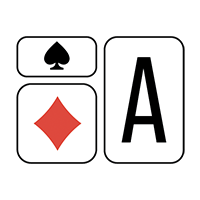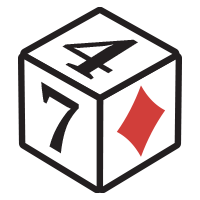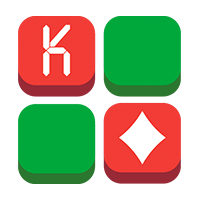This is a river spot in which I think you will want to call, and I am going to argue for folding. This is a river spot in which I think you are going to want to fold, and I'm going to make an argument calling. To make these arguments, I'm going to introduce a new thought process that's going to make bluff catching simple and easy for the rest of your poker career.
That thought process is called the bluff box.
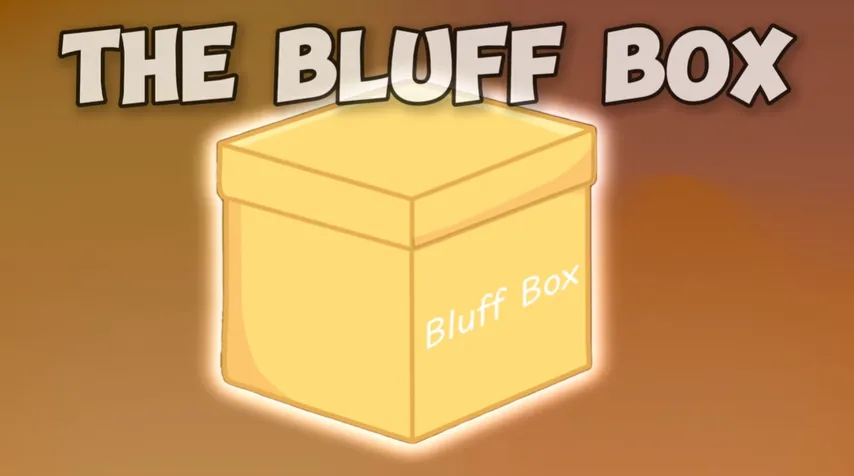
First Hand Using the Bluff Box Technique
The bluff box is a concept that's mainly going to be used on the river. So before we see what it is, let's see how we got to the river in this hand where I'm going to be advocating for hero fold. We open Kings in the cutoff; a tight-looking player makes a bad three-bet size (2.9x from 2bb to 5.75bb). This is probably a weaker type player, therefore we make a big four-bet with pocket kings—not really how we want to slow play.
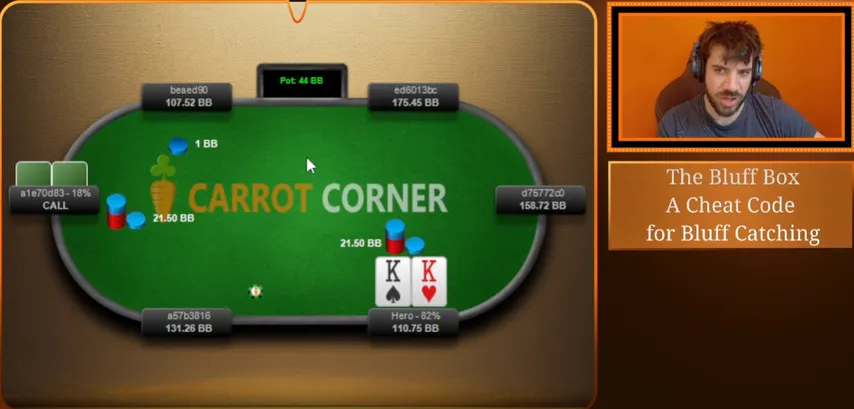
We get the call, and on , we bet one-third pot for value.
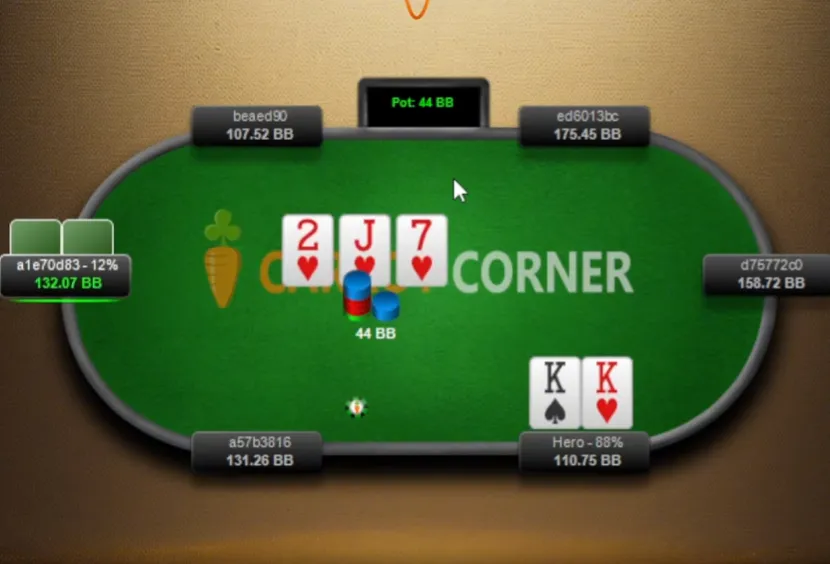
Villain calls. The turn is the . This is an interesting turn node because villain doesn't really have too many one-pair hands that we can get value from here. If you think about it, if they have Ace-Queen of Diamonds, they probably fold the flop at this juncture. If they have Ace-Queen offsuit with a heart, they probably fold pre-flop. They aren't taking any other offsuit one-heart hands with big cards in them to the turn apart from Aces. If they have tens or nines with a heart, yes, we could make one bet, but those aren't going to be a ton of combos, and we can always bet the river against them. It's not clear that we can bet multiple times against those hands for value. So all in all, there isn't really much incentive to bet this turn given that villain can still have pocket Jacks, pocket Queens slow-play, flushes, and stuff like that.
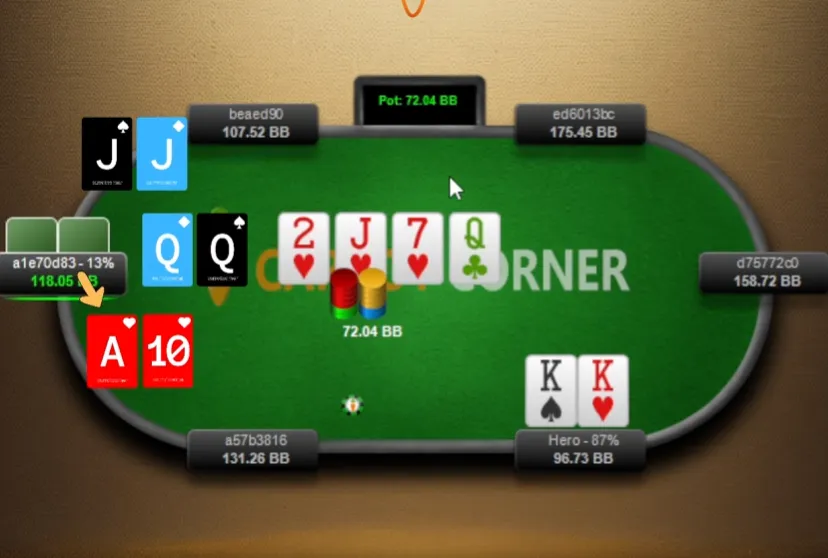
On the river, another reason that we checked the turn here was for transparency.
Transparency is a very key concept in poker. Back in the day, they would say, "I'm going to bet for information." Really, you want to check for information because free information is better than just losing the money that you would have lost by calling just to find out if they've got it—and then still not even know anyway? Whatever.
This is a spot where we're going to get a lot of transparency when villain goes all-in on this river for an effective 96.73 big blinds. What they're saying is that they have Kings beat. So you want to use the bluff box, which I'll introduce in a second, in any situation where your hand is a bluff catcher. That means that it's beating every bluff in villain's range but it's not beating a single value bet and not even chopping with a single value bet. Maybe he could have the other two combos of the other one combo of Kings here, but I think that's somewhat unlikely from pre-flop.
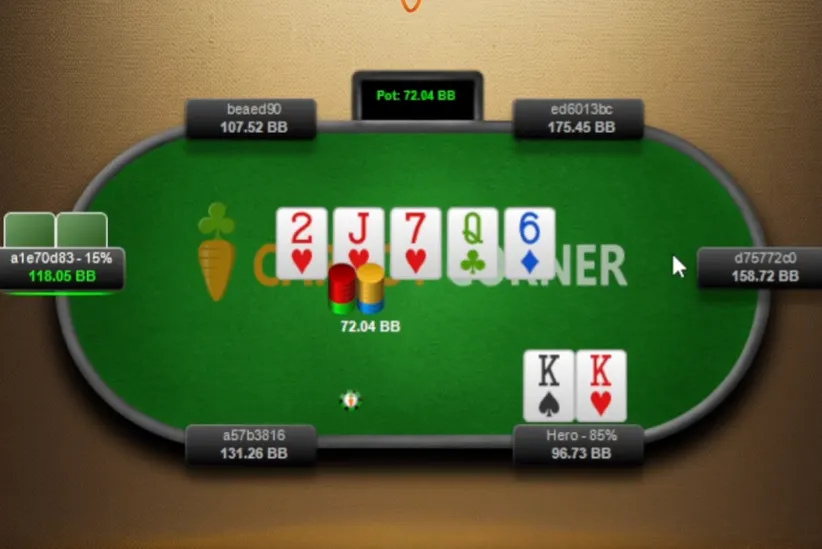
So let's make that bluff box fall from the sky. The bluff box is a concept that comes into play on the river, and it is full of hands that could potentially bluff. The bluff box is not full of hands that are definitely going to bluff, but it's the hands in villain's range that don't have much showdown value that would be tempting to turn into a bluff on the river.
The first thing you want to ask is how full is the bluff box, and the second question you're going to ask is how likely is it that the villain is taking the lid off here?

Because when the bluff box is really full and a player removes the lid—that is, has the cognition about bluffing, has the thought "I'm going to try to win by bluffing"—suddenly tons of bluff combos spill out onto the table, and villain is very quickly and suddenly grossly over-bluffing, and your call is very suddenly very winning.
On the other hand, if villain has hardly any bluffs in the bluff box to start with—like villain just doesn't get to the node in question with very many hands that would be perceived as air or low showdown value—then even if they do take off the lid, even if they do decide "I'm going to bluff in this spot," there's still only a handful of bluffs falling onto the table, and those are going to be dwarfed by value bets. When villain has a reasonable amount of value bets in their range, you could also imagine there being a value bet box—we'll come to that maybe in another video.
Let's apply the bluff box here:
How many hands that would be perceived as low to zero showdown value does your opponent land with on this river? Does he reach the river with, again retracing the action from pre-flop where he three-bets, calls a big four-bet out of position, calls a flop c-bet? How many hands are air or close to air or low showdown value that are going to reach the spot?
If you answered none, you are very nearly correct.
The hand that comes to mind here for me is Ace of Hearts and King, which might not want the five-bet stack depth, but then again, it might. That to me is the only hand that's really still hanging around here that will commonly perceive itself as a bluff.
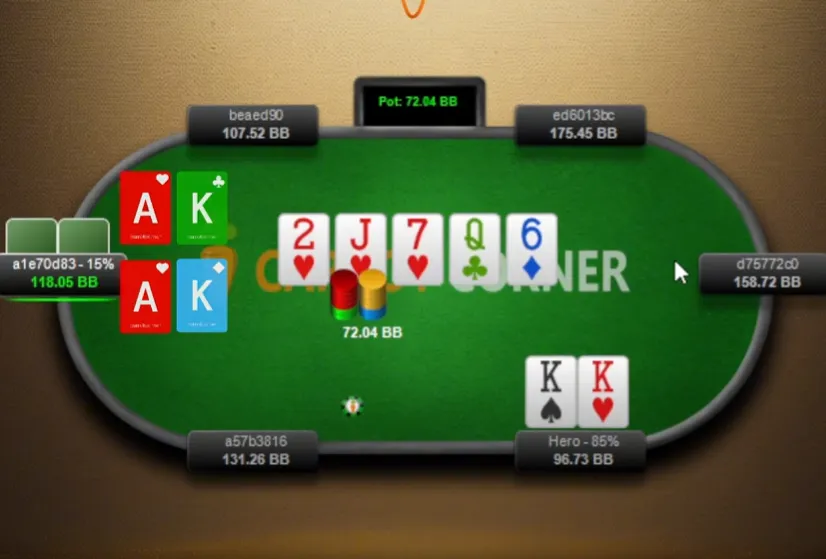
Now, you could argue that Nines with a heart is a good bluff in this situation, and maybe a solver would use a hand like that at some frequency. I don't know. But you have to think about your opponent population. If you're playing low stakes, micro stakes, even mid stakes, you're not playing against crushers. Most people are going to miss those bluffs most of the time. Those hands are not going to be in the bluff box because they're not perceived as low enough showdown value. They're not King-high with the bluff. They're still winning against Ace-King, for example. They're very intuitive just to check here.
So when villain goes all-in, we can see quite a few value hands: the aforementioned pocket Jacks, maybe a rare pocket Sevens, pocket Queens for sure, possibly a Queen-Jack suited that got a bit sticky pre-flop, some slow-played Aces...
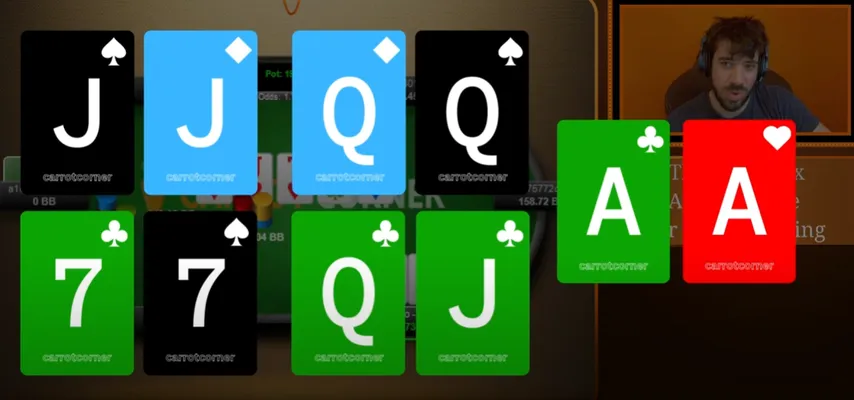
...and then a slow play of flushes like the Ace-Queen of Hearts, the Ace-10 of Hearts, maybe a hand like the six-five of hearts or four-five of hearts or Ace-five of Hearts. It's slow played flop, very intuitive thing to do here. So there's plenty of value, and the bluff box is basically empty.
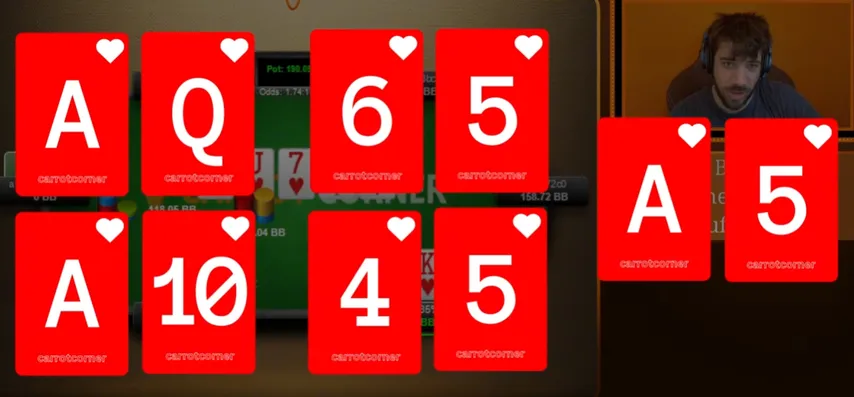
So even if villain is taking off the lid here and emptying whatever bluffs are in that box onto the table, they're still under-bluffing, and this is still a fold. You might not like it; you might not want to fold pocket kings, and you might say, "I didn't play a goddamn four-bet pot just to be folding pocket kings." Kids these days—and I don't know what the accent became—but you need to let go of the fact that it's kings. If you do the bluff box properly, it's going to lead you to the verdict of folding this hand.
I'll be totally honest with you guys: you know how long I took to fold this hand?
The answer is 0.3 seconds because I was in the zone when I played this hand. I was very dialed in, and when I was on the turn, I'd already decided that one of the absolutely amazing merits of checking back the turn was to be able to fold the river with crystal-clear confidence against the jam. I was so certain that jam was heavily under-bluffed due to the bluff box that I basically was just planning to fold immediately, and I folded instantly when this river happened. That might look insane, but when you think about it, I think this is a good fold.
Second Hand Using the Bluff Box Technique
Okay, let's look at a hand where the bluff box makes me want to call, and indeed I did call this river. This second hand we're going to look at is a spot where I think you guys all fold—okay, not all of you, but I think most of you fold here. MDA would say that people fold a lot to three barrels in a lot of situations, right? In the grade of the Carrot Poker School, where we list some MDA, we look at 3-bet pots, and one of the things that we see is that bluffing in them is pretty good on a lot of lines. A lot of reg's know that.
This was a reg. This was someone who was playing aggressively, not just one of the weak-type players in the pool, and they 3-bet here. We have on the button; we made the call.
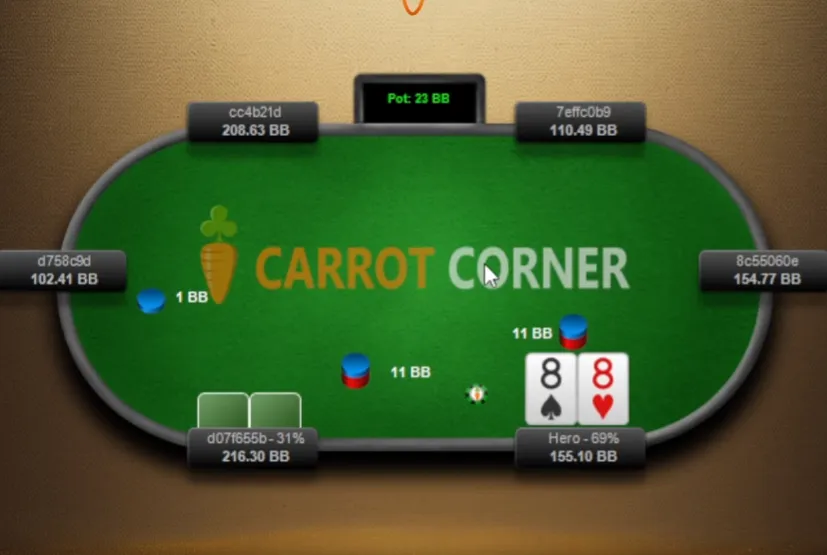
The flop was , which is a pretty ridiculous flop—really, really absurd-looking flop. Just look at that flop. Isn't it absurd? Villain bets tiny. I don't know if this is the right sizing for Queen-Queen-Queen. On Queen-Queen-x, we can have a Queen a lot, and therefore Aces and Kings are really devalued on Queen-Queen-Queen. We have a Queen hardly ever, half as often, and so Aces and Kings are just twice as good almost. So I think you can use a bigger bet on Queen-Queen-Queen than you can Queen-Queen-x.
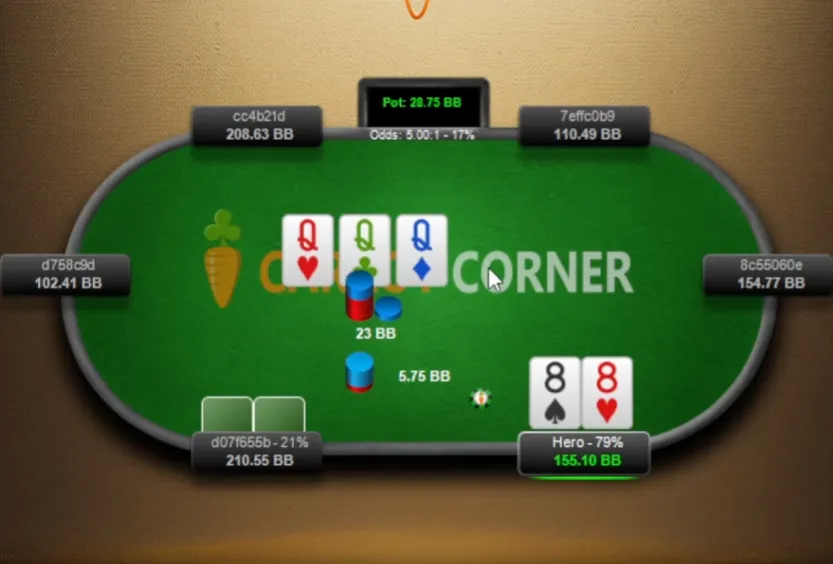
But anyway, villain goes small and then goes big on the turn , and we call again because, "we has a full house". It's a pretty good reason to call again.
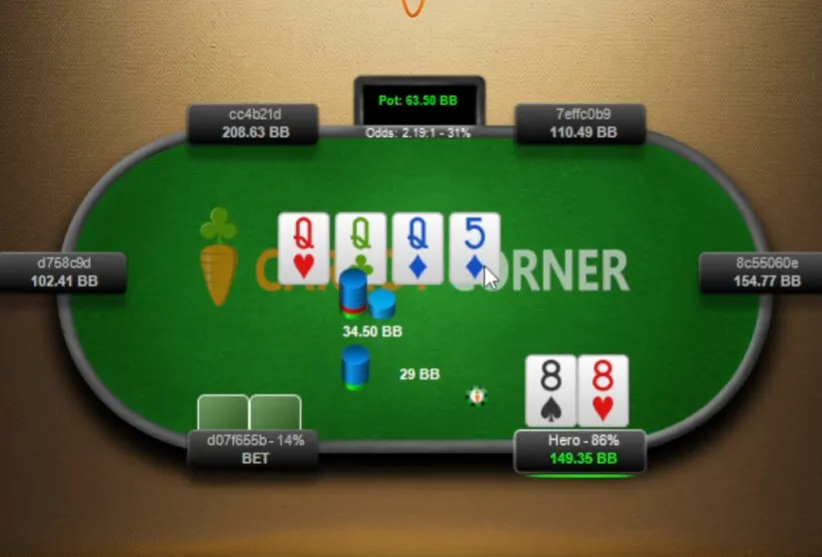
Then on the river , villain goes all-in for a size that basically denotes them as a reg kind of thing—not necessarily, but probably. But we already knew it was a reg.
The thing is that the bluff box here is kind of full—it's sort of bursting at the seams—because if you imagine that your opponent here is bluffing turn with tons of hands that are just like bluff draws, stuff that can outdraw your Eights and Nines, the most common pocket pairs you have, right? Because you might 4-bet Tens sometimes, although I wouldn't really recommend it at lower stakes. Usually, you might four-bet Jacks; you'll certainly four-bet Kings and Aces.

So when someone has a hand like King-Jack, King-Ten, Jack-Ten, Ace-King, Ace-Jack, Ace-Ten, Ten-Nine, Jack-Nine, King-Nine suited, they're going to bluff a lot. If they've landed on the river, if the bluff box is quite full of combos, and then there's someone who's quite likely to remove the lid—remember, when the lid comes off the bluff box, all the bluffs spill out. Now villain's bluffing range is the actual range from making the SP, and now we can compare it to value.

What are the value combos you're seeing? You have quad Queens. Okay, sure, you can have Ace-Queen offsuit, King-Queen offsuit—that's six combos. One Queen by no eight combos, one Queen by four Aces, one Queen by four Kings. You can have Queen-Jack suited, one combo; Queen-10 suited, one combo; Queen-9 suited, maybe one combo. So we're talking about like 11 combos of Queen-x. We're talking about Aces and Kings jamming here. They might jam; they might not. They might get too scared. They might decide to bet smaller. They might decide that quads is too likely in our range because we also have all of those Queen accents.
So there might be Aces and Kings, let's say they're in there two-thirds of the time. So we take like four combos of each—that's another eight. Add them to the 11—that's 19 value combos at a push, right? Maybe Jacks gets in once in a blue moon. Okay, it's 20 now. It's 21. Ace-Jack is 16 combos. You bluff a Jack; you're just over-bluffing automatically. You then bluff 10-9 suited; you add another four. You're now like bulbously over-bluffing. You're over-bluffing to such a disgraceful, disgusting extent that you're basically a pig lying in the garbage in your own filthy bluffs.

So when we call this river with Eights, it's because, you know, it's not because we know the lid has come off the bluff box. We don't know the opponent. We don't know whether they're bluffing. We don't know whether they even have it in them to be bluffing. But we do know that they are the type. We know that it's fairly likely that the lid is coming off. We don't know for sure. And we know, most crucially, that if the lid is coming off this bluff box, ladies and gentlemen, then this spot is very over-bluffed.
Look how clever I am. It's the wrong way to react when you win by hero calling. The right thing to do is throw a thank-you emoji at your opponent.

Of course, if you like the bluff box, the Carrot Poker School is filled with tons of analogies like that—thought experiments, metaphors, rules, theorems. It has more theorems in it than this guy's range has bluffs in it. So check it out at Carrot Corner.
I hope you've liked this video. Click the top link in the description for all of my other content, and stay tuned for more concepts like this here on YouTube. Please hit the like button, please comment, please let me know what you think. Please feel free to debate any of these hands down below. I'll see you next time. Bye for now.
